Bureau Of Standards
-
- New England Company Receives U.S. Funds To Investigate Giant Sphere As Offshore Oil Terminal Maritime Reporter, Nov 15, 1977 #46
The U.S. Government is assisting an industry-sponsored program to study and test models of ocean platforms shaped like giant concrete bubbles, each capable of holding enough fuel for 500,000 cars on a crosscountry trip.
These unique vessels, called Tuned Spheres, will be located 15 to 40 miles off the U.S.
coastline to serve as deepwater terminals for the biggest supertankers afloat. At present, no U.S. port can accommodate these supertankers.
This means that imported crude oil now must be unloaded from supertankers in deepwater Caribbean and Canadian ports, and then transshipped to the United States, using small tankers. Transshipping is said to cost gasoline and heating oil users in this country an additional $1 billion annually, which contributes to unfavorable U.S. balance of trade.
For this key reason, Tuned Sphere International, Inc., One Pine Street, Nashua, N.H., was awarded a grant by the Energy Research and Development Administration (ERDA) to test the feasibility of Tuned Spheres in the role of offshore terminal facilities. Tuned Sphere International, headquartered in Nashua, N.H., is a subsidiary of Energy Systems Corporation, the parent organization that employs recondite technology to create advanced products for industry and people.
Federal grants totaling more than $200,000 will be used to demonstrate Tuned Sphere stability under the roughest sea conditions.
Model-test monies also complement contracts received in the past six months from ERDA and Lockheed Missiles and Space Company to investigate feasibility of the Tuned Sphere as the platform for Ocean Thermal Energy Conversion powerplants under development by ERDA. These powerplants will convert temperature differences in ocean currents into electric power, or will manufacture at sea, useful products such as anhydrous ammonia fertilizers.
Interest in Tuned Spheres, according to Kenneth E. Mayo, president of Energy Systems, is being spurred by a highly favorable National Bureau of Standards technical review completed last May.
George P. Lewett, a National Bureau of Standards (NBS) official, finds Tuned Spheres "technically valid and worthy of consideration for appropriate government support." Tuned Spheres, reports NBS, "offer improved stability over the full range of weather conditions encountered on open oceans for unloading, storing, and pumping petroleum; for oil-well drilling, and as a platform for ocean-based wind, geothermal, or other powerplants." The National Bureau of Standards report notes that the Tuned Sphere's unusual shape "provides greater strength and distributes forces due to wave action." Stability of the sphere in heavy seas is made possible, the report adds, "by locating the center of mass well below the center of buoyancy. This may be changed by pumping water ballast from one tank to another." "Symmetry of Tuned Spheres eliminates pitch . . . and yaw." Neither does the oversized ball heave much in the water. "This is reduced," the report says, "by means of a large quiescent pool of water located inside the sphere. This pool is open at the bottom so that its level is adjusted automatically to average wave heights." With the forces of natural hazards and waves effectively countered, Tuned Spheres are expected to give stability over the full range of open ocean conditions, superior to that of any other vessel design.
Designed as bulk petroleum terminals, Tuned Spheres will have a 380-foot diameter to permit storage capacity of four million barrels of crude. Stored crude oil is pumped to shore via at-sea terminus of a subsea crude pipeline. Receiving facilities may be located as much as 25 miles inland.
In sum, the National Bureau of Standards says Tuned Spheres will (1) improve safety of vessels, hence personnel, (2) reduce transportation cost of oil, (3) reduce danger of oil spills, and (4) improve productivity during bad weather and sea condition.
The report also concludes that Tuned Spheres may assist relief of the nation's energy problems, because they "enhance production in offshore drilling . . . and as offshore terminals for receiving imported crude oil and petroleum products at a decrease in import costs." Charles R. Fink, vice president for operations of Tuned Sphere International, notes that "The potential $l-billion transportation cost savings to derive from Tuned Sphere deepwater terminals more than offset the cost increase which will result if legislation to require import of up to 10 percent of foreign crude in U.S.-flag vessels is passed by the Congress."
-
- Chemical Waste Incinerator Ships Discussed At SNAME Chesapeake Section Maritime Reporter, Nov 15, 1981 #19
d m i n i s t r a t i o n ; Gerald Chapman and Donald Oberacker of the Environmental Protection Agency; Rosalie Matthews of the National Bureau of Standards, and Fritz Wybenga of the Coast Guard. John Nachtsheim, president of the Society, delivered an introductory statement for the panel of
-
- Bailey Delivers Two 60-Ton Water Chilling Units To Navy Maritime Reporter, Apr 1981 #86
, N.Y., facility on a Marine Pax tester, designed and built by Bailey. The test included capacity verification, using National Bureau of Standards certified thermometers and flow meters, and sound level monitoring, with NBS-certified sound level metering. The Marine Pax tester was
-
- MarAd And EPA Propose Incinerator Ships For Hazardous Wastes Maritime Reporter, Dec 1980 #52
Ship Program was prepared by a group established in February this year. In addition to MarAd and EPA, the U.S. Coast Guard and the National Bureau of Standards participated. A 1978 study indicated that at-sea incineration would be less than half as costly as land-based incineration. EPA and
-
- New Instrument Monitors Chlorine Residuals- Literature Available Maritime Reporter, Oct 15, 1980 #72
waters at 1-500 parts per billion concentration levels. Known as the Chlortect chlorine monitor, their instrument was developed at the National Bureau of Standards and is the result of an increasing need to monitor chlorine residuals, on site, with high sensitivity and reliability. The technology
-
- Mar A d Awards Contract To Study Perishable Commodities Maritime Reporter, Jul 1977 #54
commodities could bear while returning a profit to the U.S.-flag carriers. In a related study for the Federal Railroad Administration and the National Bureau of Standards, Manalytics is examining the domestic perishables logistics system. "At this time, there is no definitive information on the potential de
-
- LNG-5 . . . Dusseldorf Maritime Reporter, Jun 15, 1977 #12
and temperature is necessary in order to calculate and invoice the quantities of LNG delivered. Experimental investigations at the National Bureau of Standards have resulted in systems with error quotients of less than 0.1 percent. The equipment needed, as well as the data collected and the experimental
-
- David Taylor Naval R&D Center Hosts Hydromechanics Meeting Maritime Reporter, Jul 15, 1981 #22
. This committee is comprised of representatives from the Naval Sea Systems Command together with representatives from Navy laboratories, National Bureau of Standards, the Office of Naval Research, and the Naval Academy. SEAHAC is responsible for making specific recommendations regarding the technical
-
- Incinerator Ship Apollo One Launched At Tacoma Boatbuilding Maritime Reporter, Apr 1984 #20
and safety standards of the U.S. Coast Guard, the Environmental Protection Agency, the Maritime Administration, and the National Bureau of Standards, among others, and are the first of their kind to meet the criteria of the American Bureau of Shipping. The Apollo One can safely
-
- Gastech 78 To Focus On World Supply And Demand For LNG And LPG Maritime Reporter, Oct 15, 1978 #27
2A—Liquefied Gas Workshop. 1. "LNG Thermophysical Properties Data and Custody Transfer," D.E. Diller, Institute for Basic Standards, National Bureau of Standards, Boulder, Colo. 2. "An LNG Cargo System Simulator for Crew Training," R.L. Blanchard, Arthur E. Sherburn, John L. Middleton, Foxboro/ Tra
-
- OUTSTANDING OCEANGOING SHIPS OF 1984 Maritime Reporter, Dec 1984 #12
and safety standards of the U.S. Coast Guard, the Environmental Protection Agency, the Maritime Administration, and the National Bureau of Standards, among others, and are the first of their kind to meet the criteria of the American Bureau of Shipping. The Apollo One can safely destroy up
-
 )
March 2024 - Marine Technology Reporter page: 42
)
March 2024 - Marine Technology Reporter page: 42NEW TECH OCEANOLOGY INTERNATIONAL 2024 Image courtesy Greg Trauthwein Image courtesy BIRNS MacArtney launches the new ultra-compact ø12.7 mm SubConn Nano connector. Innovative connectivity built on 45 years of ? eld-proven and market-trusted design. Image courtesy MacArtney Birns celebrated its 70th
-
 )
March 2024 - Marine Technology Reporter page: 35
)
March 2024 - Marine Technology Reporter page: 35Figure 1 A self-righting vehicle design with buoyancy high and weight low, WHOI’s SeaBED AUV captures the attention of a pair of curious Antarctic penguins as it is deployed from the British research vessel James Clark Ross. Vehicle designers allowed for temperature reduction of battery capacity. Recharge
-
 )
March 2024 - Marine Technology Reporter page: 17
)
March 2024 - Marine Technology Reporter page: 17• Integrity assessment, and otherwise covered, e.g., by rock dump. As for depletion of • Mitigation, intervention and repair. sacri? cial anodes, this can be dif? cult or even impossible to Selecting the best method for collecting the data these work- estimate due to poor visibility, the presence of
-
 )
March 2024 - Marine Technology Reporter page: 15
)
March 2024 - Marine Technology Reporter page: 15sensor options for longer mission periods. About the Author For glider users working in ? sheries and conservation, Shea Quinn is the Product Line Manager the Sentinel can run several high-energy passive and active of the Slocum Glider at Teledyne Webb acoustic sensors, on-board processing, and imaging
-
 )
March 2024 - Marine Technology Reporter page: 14
)
March 2024 - Marine Technology Reporter page: 14TECH FEATURE TELEDYNE SLOCUM GLIDERS to hold over 3.5 times as many lithium primary batteries as the the water column and its thrusters give it the ability to stay standard Slocum Glider, and to physically accommodate up to on track in strong currents or other dif? cult ocean condi- 8 different sensor
-
 )
March 2024 - Marine Technology Reporter page: 13
)
March 2024 - Marine Technology Reporter page: 13nyone familiar with glider hardware options integrated for a broad Glider answers that need,” said Shea autonomous underwater ve- range of missions. Quinn, Slocum Glider Product Line hicles (AUVs) is certainly “As the use of Slocum Gliders grew, Manager at TWR. A familiar with the popular- so did
-
 )
April 2024 - Maritime Reporter and Engineering News page: 43
)
April 2024 - Maritime Reporter and Engineering News page: 43“The industry is an ecosystem which includes owners, managers, mariners, shipyards, equipment makers, designers, research institutes and class societies: all of them are crucial,” – Eero Lehtovaara, Head of Regulatory & Public Affairs, ABB Marine & Ports All images courtesy ABB Marine and Ports provi
-
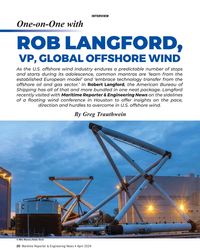 )
April 2024 - Maritime Reporter and Engineering News page: 20
)
April 2024 - Maritime Reporter and Engineering News page: 20are ‘learn from the established European model’ and ‘embrace technology transfer from the offshore oil and gas sector.’ In Robert Langford, the American Bureau of Shipping has all of that and more bundled in one neat package. Langford recently visited with Maritime Reporter & Engineering News on the sidelines
-
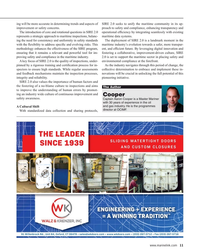 )
April 2024 - Maritime Reporter and Engineering News page: 11
)
April 2024 - Maritime Reporter and Engineering News page: 11ing will be more accurate in determining trends and aspects of SIRE 2.0 seeks to unify the maritime community in its ap- improvement or safety concerns. proach to safety and compliance, enhancing transparency and The introduction of core and rotational questions in SIRE 2.0 operational ef? ciency by
-
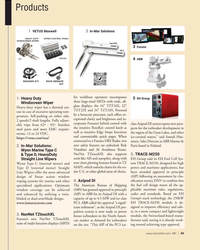 )
April 2024 - Marine News page: 43
)
April 2024 - Marine News page: 43window si? cation society DNV to con? rm that 4. Azipod DI wiping systems for marine and other specialized applications. Optimum The American Bureau of Shipping the fuel cell design meets all the ap- window coverage can be achieved (ABS) has granted approval in principle plicable maritime rules
-
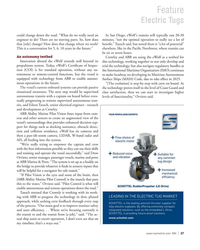 )
April 2024 - Marine News page: 37
)
April 2024 - Marine News page: 37Feature Electric Tugs could change down the road. “What do we really need an In San Diego, eWolf’s transits will typically run 20-30 engineer to do? There are no moving parts. So, how does minutes, “not the optimal operation to really see a lot of that [role] change? How does that change where we work?
-
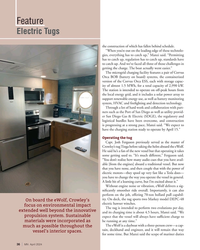 )
April 2024 - Marine News page: 36
)
April 2024 - Marine News page: 36Feature Electric Tugs the construction of which has fallen behind schedule. “When you’re out on the leading edge of these technolo- gies, everything has to catch up,” Manzi said. “Permitting has to catch up, regulation has to catch up, standards have to catch up. And we’ve faced all three of those challenge
-
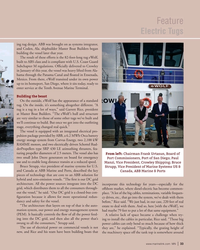 )
April 2024 - Marine News page: 33
)
April 2024 - Marine News page: 33Feature Electric Tugs ing tug design. ABB was brought on as systems integrator, and Coden, Ala. shipbuilder Master Boat Builders began building the vessel later that year. The result of these efforts is the 82-foot-long tug eWolf, built to ABS class and is compliant with U.S. Coast Guard Subchapter M
-
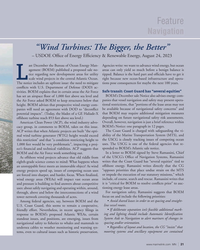 )
April 2024 - Marine News page: 21
)
April 2024 - Marine News page: 21Feature Navigation “Wind Turbines: The Bigger, the Better” – USDOE Of? ce of Energy Ef? ciency & Renewable Energy, August 24, 2023 ast December the Bureau of Ocean Energy Man- Agencies write: we want to advance wind energy, but ocean agement (BOEM) published a proposed sale no- areas can only yield so
-
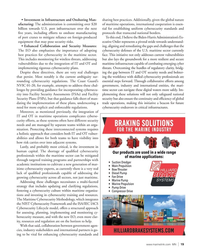 )
April 2024 - Marine News page: 19
)
April 2024 - Marine News page: 19• Investment in Infrastructure and Onshoring Man- sharing best practices. Additionally, given the global nature ufacturing: The administration is committing over $20 of maritime operations, international cooperation is essen- billion towards U.S. port infrastructure over the next tial for establishing
-
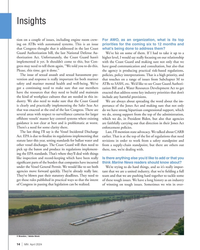 )
April 2024 - Marine News page: 14
)
April 2024 - Marine News page: 14Insights tion on a couple of issues, including engine room crew- For AWO, as an organization, what is its top ing on ATBs with automated systems. This is an issue priorities for the coming six to 12 months and that Congress thought that it addressed in the last Coast what’s being done to address them? Gua
-
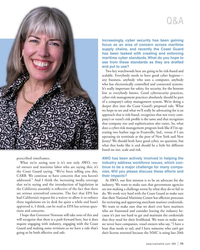 )
April 2024 - Marine News page: 11
)
April 2024 - Marine News page: 11Q&A Increasingly, cyber security has been gaining focus as an area of concern across maritime supply chains, and recently the Coast Guard has been tasked with creating and enforcing maritime cyber standards. What do you hope to see from these standards as they are drafted and put to use? Two key
-
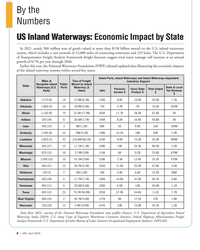 )
April 2024 - Marine News page: 8
)
April 2024 - Marine News page: 8(2019); U.S. Army Corps of Engineers Waterborne Commerce Statistics; Federal Highway Administration Freight Analysis Framework; U.S. Department of Labor Bureau of Labor Statistics Occupational Employment Statistics; IMPLAN) 8 | MN April 202
-
 )
February 2024 - Maritime Reporter and Engineering News page: 44
)
February 2024 - Maritime Reporter and Engineering News page: 44Tech Files Latest Products & Technologies MarineShaft Yanmar Hydrogen MarineShaft specializes in urgent re- Fuel Cell AIP pair/replacement of damaged rudder and Yanmar Power Technology Co., Ltd. propeller equipment along with many (Yanmar PT), a subsidiary of Yanmar on-site repair services. MarineShaft
-
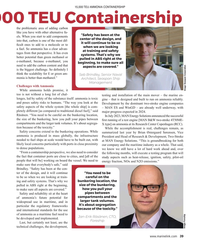 )
February 2024 - Maritime Reporter and Engineering News page: 39
)
February 2024 - Maritime Reporter and Engineering News page: 3915,000 TEU AMMONIA CONTAINERSHIP 000 TEU Containership the problematic area of adding carbon like you have with other alternative fu- “Safety has been at the els. When you start to add components center of the design, and into that, carbon is one of the most dif- it will continue to be so ? cult ones
-
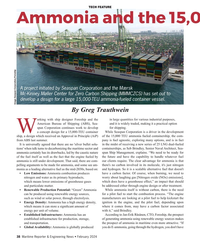 )
February 2024 - Maritime Reporter and Engineering News page: 38
)
February 2024 - Maritime Reporter and Engineering News page: 38Corporation/Foreship By Greg Trauthwein orking with ship designer Foreship and the in large quantities for various industrial purposes, American Bureau of Shipping (ABS), Sea- and it is widely traded, making it a practical option span Corporation continues work to develop for shipping. Wa concept
-
 )
February 2024 - Maritime Reporter and Engineering News page: 36
)
February 2024 - Maritime Reporter and Engineering News page: 36HYBRID 2-stroke controllable pitch propeller PTO powertrain Source: MAN Energy Solutions how the system is intended to operate, says Oskar Levander, VP Strategy & Business Development, Kongsberg Maritime. For example, a primary shaft-driven PTO rotates whenever the engine is running; a secondary one
-
 )
February 2024 - Maritime Reporter and Engineering News page: 11
)
February 2024 - Maritime Reporter and Engineering News page: 11down to a smaller size, and especially a smaller width relieves waterfront infrastructure footprints and costs. that issue. One may argue that one human with a bigger truck These 5-foot wide units will zip through the city much faster can deliver more cargo than one human with a smaller truck, and
-
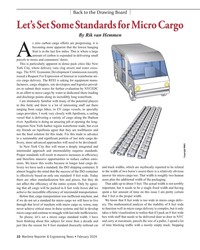 )
February 2024 - Maritime Reporter and Engineering News page: 10
)
February 2024 - Maritime Reporter and Engineering News page: 10Back to the Drawing Board Let’s Set Some Standards for Micro Cargo By Rik van Hemmen s zero carbon cargo efforts are progressing, it is becoming more apparent that the lowest hanging fruit is in the last few miles. This is where a large amount of carbon is expended in delivering small A parcels to
